阅读2
英语阅读二课文及翻译
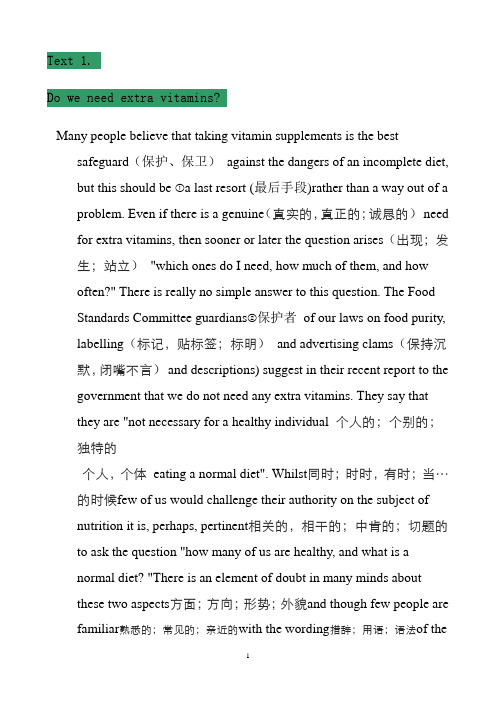
Text 1.Do we need extra vitamins?Many people believe that taking vitamin supplements is the best safeguard(保护、保卫)against the dangers of an incomplete diet, but this should be ①a last resort (最后手段)rather than a way out of a problem. Even if there is a genuine(真实的,真正的;诚恳的)need for extra vitamins, then sooner or later the question arises(出现;发生;站立)"which ones do I need, how much of them, and howoften?" There is really no simple answer to this question. The FoodStandards Committee guardians②保护者of our laws on food purity, labelling(标记,贴标签;标明)and advertising clams(保持沉默,闭嘴不言)and descriptions) suggest in their recent report to the government that we do not need any extra vitamins. They say thatthey are "not necessary for a healthy individual个人的;个别的;独特的个人,个体eating a normal diet". Whilst同时;时时,有时;当…的时候few of us would challenge their authority on the subject ofnutrition it is, perhaps, pertinent相关的,相干的;中肯的;切题的to ask the question "how many of us are healthy, and what is anormal diet? "There is an element of doubt in many minds aboutthese two aspects方面;方向;形势;外貌and though few people are familiar熟悉的;常见的;亲近的with the wording措辞;用语;语法of theFood Standards Report they do wonder instinctively本能地if theyare eating the right things. The blame for faulty eating habits is often placed at the door of the ubiquitous③(a. being everywhere, esp. atthe same time 普遍存在的)junk and convenience foods. As wehave seen, some of these are not the criminals they are made out tobe White bread is only slightly些微地,轻微地;纤细地less nutritious than brown bread and frozen vegetables can be almost as "fresh" asfresh food. There are very few foods which can really be described as pure rubbish. Many pre-packed goods contain too much sugar andwe would all benefit by avoiding these, but most tinned, processed处理的,加工过的and dried foods contain useful amounts of fat,protein, carbohydrate④(n. 碳水化合物), vitamins and minerals矿物;矿产,矿产品. The addition of a small amount of fruit or a side salad to convenience foods such as pizzas or hamburgers can turn asnack小吃,快餐;一份,部分into a well-balanced meal.许多人认为,服用维生互补剂是防止出现饮食营养不均衡情况的最好防范办法,但这是解决这一问题的方法中最不可行的作法。
托福TPO27阅读Passage2原文文本+题目+答案解析
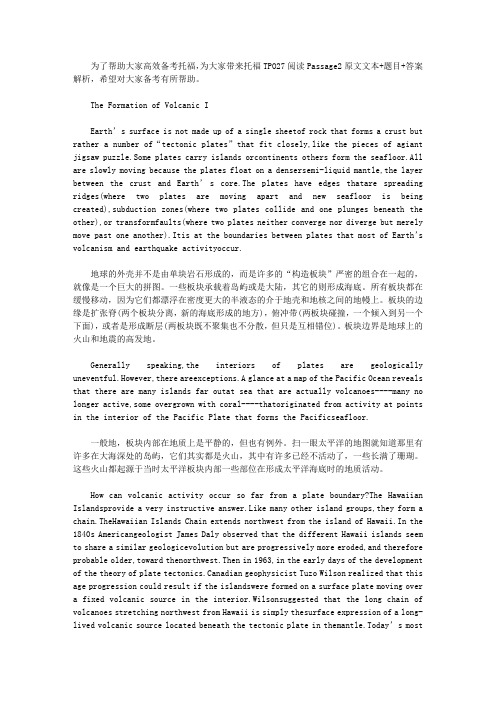
为了帮助大家高效备考托福,为大家带来托福TPO27阅读Passage2原文文本+题目+答案解析,希望对大家备考有所帮助。
The Formation of Volcanic I Earth’s surface is not made up of a single sheetof rock that forms a crust but rather a number of“tectonic plates”that fit closely,like the pieces of agiant jigsaw puzzle.Some plates carry islands orcontinents others form the seafloor.All are slowly moving because the plates float on a densersemi-liquid mantle,the layer between the crust and Earth’s core.The plates have edges thatare spreading ridges(where two plates are moving apart and new seafloor is being created),subduction zones(where two plates collide and one plunges beneath the other),or transformfaults(where two plates neither converge nor diverge but merely move past one another).Itis at the boundaries between plates that most of Earth’s volcanism and earthquake activityoccur. 地球的外壳并不是由单块岩石形成的,而是许多的“构造板块”严密的组合在一起的,就像是一个巨大的拼图。
剑桥雅思真题8-阅读Test 2(附答案)
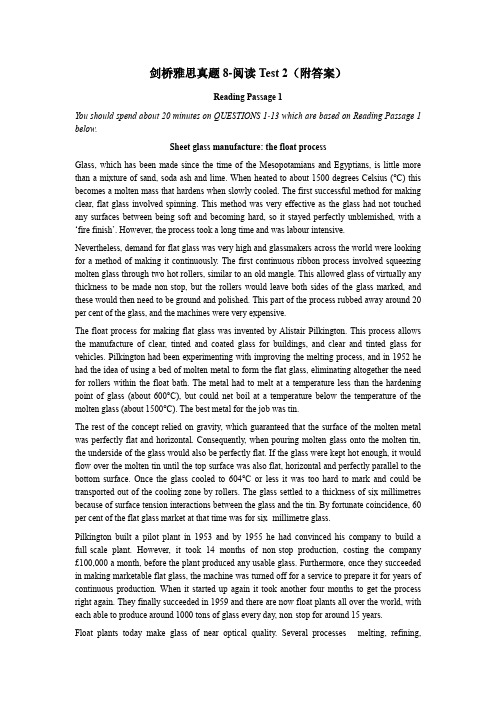
剑桥雅思真题8-阅读Test 2(附答案)Reading Passage 1You should spend about 20 minutes on QUESTIONS 1-13 which are based on Reading Passage 1 below.Sheet glass manufacture: the float processGlass, which has been made since the time of the Mesopotamians and Egyptians, is little more than a mixture of sand, soda ash and lime. When heated to about 1500 degrees Celsius (°C) this becomes a molten mass that hardens when slowly cooled. The first successful method for making clear, flat glass involved spinning. This method was very effective as the glass had not touched any surfaces between being soft and becoming hard, so it stayed perfectly unblemished, with a ‘fire finish’. However, the process took a long time and was labour intensive.Nevertheless, demand for flat glass was very high and glassmakers across the world were looking for a method of making it continuously. The first continuous ribbon process involved squeezing molten glass through two hot rollers, similar to an old mangle. This allowed glass of virtually any thickness to be made non-stop, but the rollers would leave both sides of the glass marked, and these would then need to be ground and polished. This part of the process rubbed away around 20 per cent of the glass, and the machines were very expensive.The float process for making flat glass was invented by Alistair Pilkington. This process allows the manufacture of clear, tinted and coated glass for buildings, and clear and tinted glass for vehicles. Pilkington had been experimenting with improving the melting process, and in 1952 he had the idea of using a bed of molten metal to form the flat glass, eliminating altogether the need for rollers within the float bath. The metal had to melt at a temperature less than the hardening point of glass (about 600°C), but could net boil at a temperature below the temperature of the molten glass (about 1500°C). The best metal for the job was tin.The rest of the concept relied on gravity, which guaranteed that the surface of the molten metal was perfectly flat and horizontal. Consequently, when pouring molten glass onto the molten tin, the underside of the glass would also be perfectly flat. If the glass were kept hot enough, it would flow over the molten tin until the top surface was also flat, horizontal and perfectly parallel to the bottom surface. Once the glass cooled to 604°C or less it was too hard to mark and could be transported out of the cooling zone by rollers. The glass settled to a thickness of six millimetres because of surface tension interactions between the glass and the tin. By fortunate coincidence, 60 per cent of the flat glass market at that time was for six- millimetre glass.Pilkington built a pilot plant in 1953 and by 1955 he had convinced his company to build a full-scale plant. However, it took 14 months of non-stop production, costing the company £100,000 a month, before the plant produced any usable glass. Furthermore, once they succeeded in making marketable flat glass, the machine was turned off for a service to prepare it for years of continuous production. When it started up again it took another four months to get the process right again. They finally succeeded in 1959 and there are now float plants all over the world, with each able to produce around 1000 tons of glass every day, non-stop for around 15 years.Float plants today make glass of near optical quality. Several processes -melting, refining,homogenising - take place simultaneously in the 2000 tonnes of molten glass in the furnace. They occur in separate zones in a complex glass flow driven by high temperatures. It adds up to a continuous melting process, lasting as long as 50 hours, that delivers glass smoothly and continuously to the float bath, and from there to a coating zone and finally a heat treatment zone, where stresses formed during cooling are relieved.The principle of float glass is unchanged since the 1950s. However, the product has changed dramatically, from a single thickness of 6.8 mm to a range from sub-millimetre to 25 mm, from a ribbon frequently marred by inclusions and bubbles to almost optical perfection. To ensure the highest quality, inspection takes place at every stage. Occasionally, a bubble is not removed during refining, a sand grain refuses to melt, a tremor in the tin puts ripples into the glass ribbon. Automated on-line inspection does two things. Firstly, it reveals process faults upstream that can be corrected. Inspection technology allows more than 100 million measurements a second to be made across the ribbon, locating flaws the unaided eye would be unable to see. Secondly, it enables computers downstream to steer cutters around flaws.Float glass is sold by the square metre, and at the final stage computers translate customer requirements into patterns of cuts designed to minimise waste.Question 1-8Complete the table and diagram below.Choose NO MORE THAN TWO WORDS from the passage for each answer.Write your answers in boxes on your answer sheet.Early methods of producing flat glassQuestion 9-13Do the following statements agree with the information given in Reading Passage 1?In boxes 9-13 on your answer sheet, writeTRUE if the statement agrees with the informationFALSE if the statement contradicts the informationNOT GIVEN if there is no information on this in the passage9. The metal used in the float process had to have specific properties.10. Pilkington invested some of his own money in his float plant.11. Pilkington's first full-scale plant was an instant commercial success.12. The process invented by Pilkington has now been improved.puters are better than humans at detecting faults in glass.Reading Passage 2You should spend about 20 minutes on QUESTIONS 14-26 which are based on Reading Passage 2 below.The Little Ice AgeA This book will provide a detailed examination of the Little Ice Age and other climatic shifts, but, before I embark on that, let me provide a historical context. We tend to think of climate - as opposed to weather -as something unchanging, yet humanity has been at the mercy of climate change for its entire existence, with at least eight glacial episodes in the past 730,000 years. Our ancestors adapted to the universal but irregular global warming since the end of the last great Ice Age, around 10,000 years ago, with dazzling opportunism. They developed strategies for surviving harsh drought cycles, decades of heavy rainfall or unaccustomed cold; adopted agriculture and stock-raising, which revolutionized human life; and founded the world's first pre-industrial civilizations in Egypt, Mesopotamia and the Americas. But the price of sudden climate change, in famine, disease and suffering, was often high.B The Little Ice Age lasted from roughly 1300 until the middle of the nineteenth century. Only two centuries ago, Europe experienced a cycle of bitterly cold winters; mountain glaciers in the Swiss Alps were the lowest in-recorded memory, and pack ice surrounded Iceland for much of the year. The climatic events of the Little Ice Age did more than help shape the modern world. They are the deeply important context for the current unprecedented global warming. The Little Ice Age was far from a deep freeze, however; rather an irregular seesaw of rapid climatic shifts, few lasting more than a quarter-century, driven by complex and still little understood interactions between the atmosphere and the ocean. The seesaw brought cycles of intensely cold winters and easterly winds, then switched abruptly to years of heavy spring and early summer rains, mild winters, and frequent Atlantic storms, or to periods of droughts, light northeasterly winds, and summer heat waves.C Reconstructing the climate changes of the past is extremely difficult, because systematic weather observations began only a few centuries ago, in Europe and North America. Records from India and tropical Africa are even more recent. For the time before records began, we have only 'proxy records' reconstructed largely from tree rings and ice cores, supplemented by a few incomplete written accounts. We now have hundreds of tree-ring records from throughout thenorthern hemisphere, and many from south of the equator, too, amplified with a growing body of temperature data from ice cores drilled in Antarctica, Greenland the Peruvian Andes, and other locations. We are close to knowledge of annual summer and winter temperature variations over much of the northern hemisphere going back 600 years.D This book is a narrative history of climatic shifts during the past ten centuries, and some of the ways in which people in Europe adapted to them. Part One describes the Medieval Warm Period, roughly 900 t0 1200. During these three centuries, Norse voyagers from Northern Europe explored northern seas, settled Greenland, and visited North America. It was not a time of uniform warmth, for then, as always since the Great Ice Age, there were constant shifts in rainfall and temperature. Mean European temperatures were about the same as today, perhaps slightly cooler.E It is known that the Little Ice Age cooling began in Greenland and the Arctic in about 1200. As the Arctic ice pack spread southward, Norse voyages to the west were rerouted into the open Atlantic, then ended altogether. Storminess increased in the North Atlantic and North Sea. Colder, much wetter weather descended on Europe between 1315 and 1319, when thousands perished in a continent-wide famine. By 1400, the weather had become decidedly more unpredictable and stormier, with sudden shifts and lower temperatures that culminated in the cold decades of the late sixteenth century. Fish were a vital commodity in growing towns and cities, where food supplies were a constant concern. Dried cod and herring were already the staples of the European fish trade, but changes in water temperatures forced fishing fleets to work further offshore. The Basques, Dutch, and English developed the first offshore fishing boats adapted to a colder and stormier Atlantic. A gradual agricultural revolution in northern Europe stemmed from concerns over food supplies at a time of rising populations. The revolution involved intensive commercial farming and the growing of animal fodder on land not previously used for crops. The increased productivity from farmland made some countries self-sufficient in grain and livestock and offered effective protection against famine.F Global temperatures began to rise slowly after 1850, with the beginning of the Modern Warm Period. There was a vast migration from Europe by land-hungry farmers and others, to which the famine caused by the Irish potato blight contributed, to North America, Australia, New Zealand, and southern Africa. Millions of hectares of forest and woodland fell before the newcomers' axes between 1850 and -1890, as intensive European farming methods expanded across the world. The unprecedented land clearance released vast quantities of carbon dioxide into the atmosphere, triggering for the first time humanly caused global warming. Temperatures climbed more rapidly in the twentieth century as the use of fossil fuels proliferated and greenhouse gas levels continued to soar. The rise has been even steeper since the early 1980s. The Little Ice Age has given way to a new climatic regime, marked by prolonged and steady warming. At the same time, extreme weather events like Category 5 hurricanes are becoming more frequent.Question 14-17Reading Passage 2 has seven paragraphs, A-F.Choose the correct heading for paragraphs B and D–F from the list of headings below.write the correct number, i-ix, in boxes 14-17 on your answer sheet.16Paragraph E17 Paragraph FQuestion 18-22Complete the summary using the list of words, A-I, below.Write the correct letter, A-I, in boxes 1-5 on your answer sheet.Weather during the Little Ice AgeDocumentation of past weather conditions is limited: our main sources of knowledge of inthedistant past are 18 …………and19 ………… . We can deduce that the Little Ice Age was a time of 20 ………… , rather than of consistent freezing. Within it there were some periods of very cold winters, others of 21 …………and heavy rain, and yet others that saw 22 …………with no rain at all.Question 23-Classify the following events as occurring during theA. Medieval Warm PeriodB. Little Ice AgeC. Modem Warm PeriodWrite the correct letter, A. B or C in boxes 23-26 on your answer sheet.23. Many Europeans started farming abroad.24. The cutting down of trees began to affect the climate.25. Europeans discovered other lands.26. Changes took place in fishing patterns.Reading Passage 3You should spend about 20 minutes on QUESTIONS 27-40 which are based on Reading Passage 3 below.The meaning and power of smellThe sense of smell, or olfaction, is powerful. Odours affect us on a physical, psychological and social level. For the most part, however, we breathe in the aromas which surround us without being consciously aware of their importance to us. It is only when the faculty of smell is impaired for some reason that we begin to realise the essential role the sense of smell plays in our sense of well-being.A A survey conducted by Anthony Synott at Montreal's Concordia University asked participants to comment on how important smell was to them in their lives. It became apparent that smell can evoke strong emotional responses. A scent associated with a good experience can bring a rush of joy, while a foul odour or one associated with a bad memory may make us grimace with disgust. Respondents to the survey noted that many of their olfactory likes and dislikes were based on emotional associations. Such associations can be powerful enough so that odours that we would generally label unpleasant become agreeable, and those that we would generally consider fragrant become disagreeable for particular individuals. The perception of smell, therefore, consists not only of the sensation of the odours themselves, but of the experiences and emotions associated with them.B Odours are also essential cues in social bonding. One respondent to the survey believed that there is no true emotional bonding without touching and smelling a loved one. In fact, infants recognise the odours of their mothers soon after birth and adults can often identify their children or spouses by scent. In one well-known test, women and men were able to distinguish by smell alone clothing worn by their marriage partners from similar clothing worn by other people. Most of the subjects would probably never have given much thought to odour as a cue for identifying family members before being involved in the test, but as the experiment revealed, even when not consciously considered, smells register.C In spite of its importance to our emotional and sensory lives, smell is probably the most undervalued sense in many cultures. The reason often given for the low regard in which smell is held is that, in comparison with its importance among animals, the human sense of smell is feeble and undeveloped. While it is true that the olfactory powers of humans are nothing like as fine as those possessed by certain animals, they are still remarkably acute. Our noses are able to recognisethousands of smells, and to perceive odours which are present only in extremely small quantities.D Smell, however, is a highly elusive phenomenon. Odours, unlike colours, for instance, cannot be named in many languages because the specific vocabulary simply doesn't exist. 'It smells like…., ' we have to say when describing an odour, struggling to express our olfactory experience. Nor can odours be recorded: there is no effective way to either capture or store them over time. In the realm of olfaction, we must make do with descriptions and recollections. This has implications for olfactory research.E Most of the research on smell undertaken to date has been of a physical scientific nature. Significant advances have been made in the understanding of the biological and chemical nature of olfaction, but many fundamental questions have yet to be answered. Researchers have still to decide whether smell is one sense or two -one responding to odours proper and the other registering odourless chemicals in the air. Other unanswered questions are whether the nose is the only part of the body affected by odours, and how smells can be measured objectively given the nonphysical components. Questions like these mean that interest in the psychology of smell is inevitably set to play an increasingly important role for researchers.F However, smell is not simply a biological and psychological phenomenon. Smell is cultural, hence it is a social and historical phenomenon. Odours are invested with cultural values: smells that are considered to be offensive in some cultures may be perfectly acceptable in others. Therefore, our sense of smell is a means of, and model for, interacting with the world. Different smells can provide us with intimate and emotionally charged experiences and the value that we attach to these experiences is interiorised by the members of society in a deeply personal way. Importantly, our commonly held feelings about smells can help distinguish us from other cultures. The study of the cultural history of smell is, therefore, in a very real sense, an investigation into the essence of human culture.Question 27-32Reading Passage 3 has seven paragraphs, A-F.Choose the correct heading for each paragraph from the list of headings below.Write the correct number, i-viii, in boxes 27-32 on your answer sheet.28Paragraph B29 Paragraph C30 Paragraph D31 Paragraph E32Paragraph FQuestions 33-36Choose the correct letter, A, B, C or D.Write the correct letter in boxes 33-36 on your answer sheet.33 According to the introduction, we become aware of the importance of smell whenA we discover a new smell.B we experience a powerful smell.C our ability to smell is damaged.D we are surrounded by odours.34 The experiment described in paragraph BA shows how we make use of smell without realising it.B demonstrates that family members have a similar smell.C proves that a sense of smell is learnt.D compares the sense of smell in males and females.35 What is the writer doing in paragraph C?A supporting other researchB making a proposalD describing limitations36 What does the writer suggest about the study of smell in the atmosphere in paragraph E?A The measurement of smell is becoming more accurate.B Researchers believe smell is a purely physical reaction.C Most smells are inoffensive.D Smell is yet to be defined.Questions 37-40Complete the sentences below.Choose ONE WORD ONLY from the passage for each answer.Write your answers in boxes 37-40 on your answer sheet.37 Tests have shown that odours can help people recognise the ………… belonging to theirhusbands and wives.38 Certain linguistic groups may have difficulty describing smell because they lack the appropriate ………… .39 The sense of smell may involve response to ………… which do not smell, in addition to obvious odours.40 Odours regarded as unpleasant in certain ………… are not regarded as unpleasant in others.参考答案1 spinning2 (perfectly) unblemished3 labour/labor-intensive4 thickness5 marked6 (molten) glass7 (molten) tin/metal8 rollers9 TRUE10 NOT GIVEN11 FALSE12 TRUE13 TRUE14 ii15 vii16 ix17 iv18&19 (IN EITHER ORDER) C B20A21H22G23C24C25A26B27 viii28 ii29 vi30 i31 iii32 v33C34A35C36D37 clothing38 vocabulary39 chemicals40 cultures。
托福TPO25阅读Passage2原文文本+题目+答案解析
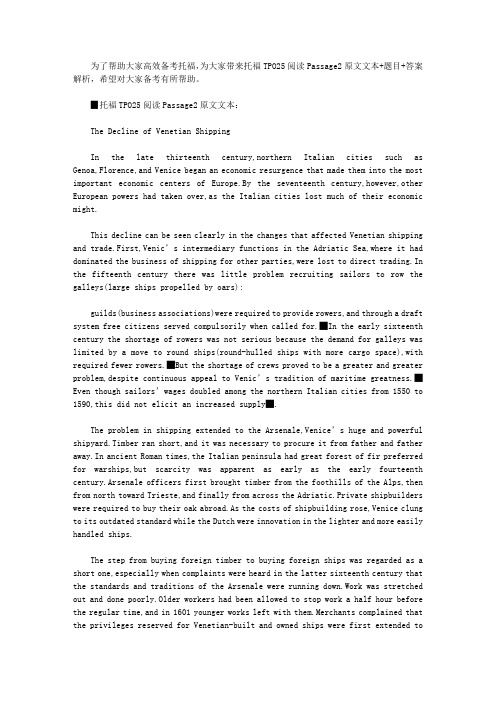
为了帮助大家高效备考托福,为大家带来托福TPO25阅读Passage2原文文本+题目+答案解析,希望对大家备考有所帮助。
▉托福TPO25阅读Passage2原文文本: The Decline of Venetian Shipping In the late thirteenth century,northern Italian cities such as Genoa,Florence,and Venice began an economic resurgence that made them into the most important economic centers of Europe.By the seventeenth century,however,other European powers had taken over,as the Italian cities lost much of their economic might. This decline can be seen clearly in the changes that affected Venetian shipping and trade.First,Venic’s intermediary functions in the Adriatic Sea,where it had dominated the business of shipping for other parties,were lost to direct trading.In the fifteenth century there was little problem recruiting sailors to row the galleys(large ships propelled by oars): guilds(business associations)were required to provide rowers,and through a draft system free citizens served compulsorily when called for.█In the early sixteenth century the shortage of rowers was not serious because the demand for galleys was limited by a move to round ships(round-hulled ships with more cargo space),with required fewer rowers.█But the shortage of crews proved to be a greater and greater problem,despite continuous appeal to Venic’s tradition of maritime greatness.█Even though sailors’wages doubled among the northern Italian cities from 1550 to 1590,this did not elicit an increased supply█. The problem in shipping extended to the Arsenale,Venice’s huge and powerful shipyard.Timber ran short,and it was necessary to procure it from father and father away.In ancient Roman times,the Italian peninsula had great forest of fir preferred for warships,but scarcity was apparent as early as the early fourteenth century.Arsenale officers first brought timber from the foothills of the Alps,then from north toward Trieste,and finally from across the Adriatic.Private shipbuilders were required to buy their oak abroad.As the costs of shipbuilding rose,Venice clung to its outdated standard while the Dutch were innovation in the lighter and more easily handled ships. The step from buying foreign timber to buying foreign ships was regarded as a short one,especially when complaints were heard in the latter sixteenth century that the standards and traditions of the Arsenale were running down.Work was stretched out and done poorly.Older workers had been allowed to stop work a half hour before the regular time,and in 1601 younger works left with them.Merchants complained that the privileges reserved for Venetian-built and owned ships were first extended tothose Venetians who bought ships from abroad and then to foreign-built and owned vessels.Historian Frederic Lane observes that after the loss of ships in battle in the late sixteenth century,the shipbuilding industry no long had the capacity to recover that it had displayed at the start of the century. The conventional explanation for the loss of Venetian dominance in trade is establishment of the Portuguese direct sea route to the East,replacing the overland Silk Road from the Black sea and the highly profitable Indian Ocean-caravan-eastern Mediterranean route to Venice.The Portuguese Vasco da Gama’s Voyaga around southern Africa to India took place at the end of the fifteenth century,and by 1502 the trans-Abrabian caravan route had been cut off by political unrest. The Venetian Council finally allowed round ships to enter the trade that was previously reserved for merchant galleys,thus reducing transport cost by one third.Prices of spices delivered by ship from the eastern Mediterranean came to equal those of spices transported by Paortuguese vessels,but the increase in quantity with both routes in operation drove the price far down.Gradually,Venice’s role as a storage and distribution center for spices and silk,dyes cotton,and gold decayed,and by the early seventeenth century Venice had lost its monopoly in markets such as France and southern Germany. Venetian shipping had started to decline from about 1530-before the entry into the Mediterranean of large volumes of Dutch and Britishshipping-and was clearly outclassed by the end of the century.A contemporary of Shakespeare(1564-1616)observed that the productivity of Italian shipping had declined,compared with that of the British,because of conservatism and loss of expertise.Moreover,Italian sailors were deserting and emigrating,and captains,no longer recruited from the ranks of nobles,were weak on navigations. This decline can be seen clearly in the changes that affected Venetian shipping and trade.First,Venic’s intermediary functions in the Adriatic Sea,where it had dominated the business of shipping for other parties,were lost to direct trading.century there was little In the fifteenth problem recruiting sailors to row the galleys(large ships propelled by oars):guilds(business associations)were required to provide rowers,and through a draft system free citizens served compulsorily when called for.█In the early sixteenth century the shortage of rowers was not serious because the demand for galleys was limited by a move to round ships(round-hulled ships with more cargo space),with required fewer rowers.█But the shortage of crews proved to be a greater and greater problem,despite continuous appeal to Venic’s tradition of maritime greatness.█Even though sailors’wages doubled among the northern Italian cities from 1550 to 1590,this did not elicit an increased supply█. ▉托福TPO25阅读Passage2题目:。
托福TPO29阅读Passage2原文文本+题目+答案解析
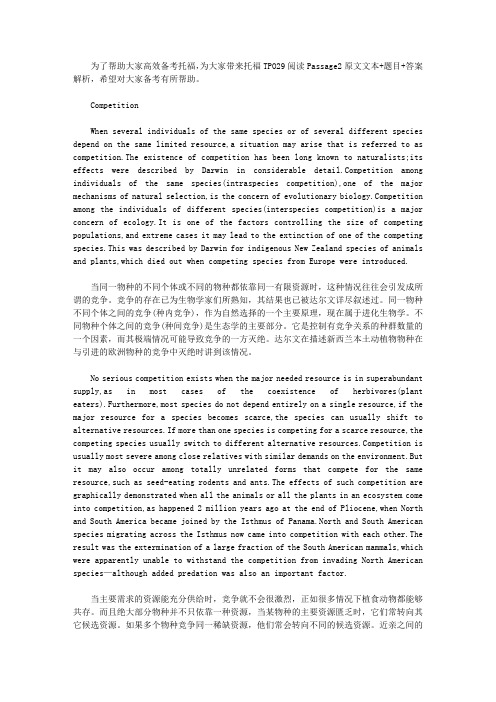
为了帮助大家高效备考托福,为大家带来托福TPO29阅读Passage2原文文本+题目+答案解析,希望对大家备考有所帮助。
Competition When several individuals of the same species or of several different species depend on the same limited resource,a situation may arise that is referred to as competition.The existence of competition has been long known to naturalists;its effects were described by Darwin in considerable petition among individuals of the same species(intraspecies competition),one of the major mechanisms of natural selection,is the concern of evolutionary petition among the individuals of different species(interspecies competition)is a major concern of ecology.It is one of the factors controlling the size of competing populations,and extreme cases it may lead to the extinction of one of the competing species.This was described by Darwin for indigenous New Zealand species of animals and plants,which died out when competing species from Europe were introduced. 当同一物种的不同个体或不同的物种都依靠同一有限资源时,这种情况往往会引发成所谓的竞争。
2022 考研英语阅读真题Text 2(英语二)

2022 Text 2(英语⼆)"不退休"的晚年⽣活More Americans are opting to work well into retirement, a growing trend that threatens to upend the old workforce model.One in three Americans who are at least 40 have or plan to have a job in retirement to prepare for a longer life, according to a survey conducted by for TD Ameritrade.Even more surprising is that more than half of "unretirees" — those who plan to work in retirement or went back to work after retiring — said they would be employed in their later years even if they had enough money to settle down, the survey showed.Financial needs aren't the only culprit for the "unretirement" trend.Other reasons, according to the study, include personal fulfillment such as staying mentally fit, preventing boredom or avoiding depression.About 72% of "unretire" respondents said that they would return to work once retired to keep mentally fit while 59% said it would be tied to making ends meet."The concept of retirement is evolving," said Christine Russell, senior manager of retirement at TD Ameritrade. "It's not just about finances. The value of work is also driving folks to continue working past retirement."One reason for the change in retirement patterns: Americans are living longer.越来越多的美国⼈选择在退休后好好⼯作,这⼀⽇益增⻓的趋势有可能颠覆旧的劳动⼒模式。
说明文2阅读答案
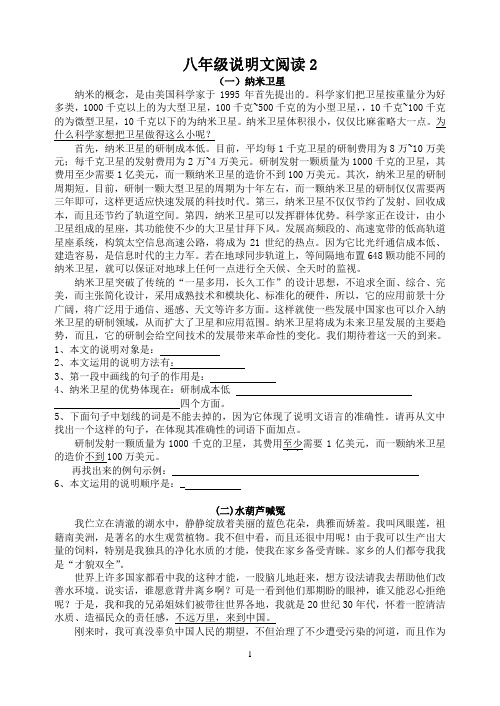
八年级说明文阅读2(一)纳米卫星纳米的概念,是由美国科学家于1995年首先提出的。
科学家们把卫星按重量分为好多类,1000千克以上的为大型卫星,100千克~500千克的为小型卫星,,10千克~100千克的为微型卫星,10千克以下的为纳米卫星。
纳米卫星体积很小,仅仅比麻雀略大一点。
为什么科学家想把卫星做得这么小呢?首先,纳米卫星的研制成本低。
目前,平均每1千克卫星的研制费用为8万~10万美元;每千克卫星的发射费用为2万~4万美元。
研制发射一颗质量为1000千克的卫星,其费用至少需要1亿美元,而一颗纳米卫星的造价不到100万美元。
其次,纳米卫星的研制周期短。
目前,研制一颗大型卫星的周期为十年左右,而一颗纳米卫星的研制仅仅需要两三年即可,这样更适应快速发展的科技时代。
第三,纳米卫星不仅仅节约了发射、回收成本,而且还节约了轨道空间。
第四,纳米卫星可以发挥群体优势。
科学家正在设计,由小卫星组成的星座,其功能使不少的大卫星甘拜下风。
发展高频段的、高速宽带的低高轨道星座系统,构筑太空信息高速公路,将成为21世纪的热点。
因为它比光纤通信成本低、建造容易,是信息时代的主力军。
若在地球同步轨道上,等间隔地布置648颗功能不同的纳米卫星,就可以保证对地球上任何一点进行全天候、全天时的监视。
纳米卫星突破了传统的“一星多用,长久工作”的设计思想,不追求全面、综合、完美,而主张简化设计,采用成熟技术和模块化、标准化的硬件,所以,它的应用前景十分广阔,将广泛用于通信、遥感、天文等许多方面。
这样就使一些发展中国家也可以介入纳米卫星的研制领域,从而扩大了卫星和应用范围。
纳米卫星将成为未来卫星发展的主要趋势,而且,它的研制会给空间技术的发展带来革命性的变化。
我们期待着这一天的到来。
1、本文的说明对象是:2、本文运用的说明方法有:3、第一段中画线的句子的作用是:4、纳米卫星的优势体现在:研制成本低四个方面。
5、下面句子中划线的词是不能去掉的,因为它体现了说明文语言的准确性。
新标准大学英语长篇阅读2

新标准大学英语长篇阅读2
新标准大学英语长篇阅读2是一本为大学生编写的英语教材,旨在帮助学生提高阅读能力,拓展词汇量,增强语言表达能力。
本书共分为六个单元,每个单元涵盖了不同主题的文章,内容涉及社会、文化、科技等多个领域,既能帮助学生了解世界各地的文化和风土人情,又能拓展学生的知识面,提高他们的综合素质。
在学习本书的过程中,学生不仅能够提高阅读速度和理解能力,还能通过阅读不同主题的文章,培养自己的思维能力和分析能力。
同时,本书还提供了丰富的词汇和语法练习,帮助学生巩固所学知识,提高语言表达能力。
每篇文章都精心选取,内容丰富多彩,语言生动优美。
通过阅读这些文章,学生能够了解不同国家的文化传统、风土人情,增长见识,开阔视野。
同时,这些文章还能引发学生对于社会、科技等方面的思考,激发学生的学习兴趣,激励他们积极思考,勇于探索未知领域。
本书的编写注重了语言的生动性和实用性,文章内容贴近生活,贴近学生的学习和生活实际,让学生在阅读的过程中能够感受到语言的魅力,增强学习的乐趣。
同时,本书还提供了丰富的课后练习和参考答案,方便学生巩固所学知识,检验学习效果。
总之,新标准大学英语长篇阅读2是一本内容丰富、贴近生活、注重实用性的英语教材,适合大学生使用。
通过学习本书,学生不仅能够提高英语阅读能力,还能够拓展知识面,增强综合素质,是一本理想的英语教材。
- 1、下载文档前请自行甄别文档内容的完整性,平台不提供额外的编辑、内容补充、找答案等附加服务。
- 2、"仅部分预览"的文档,不可在线预览部分如存在完整性等问题,可反馈申请退款(可完整预览的文档不适用该条件!)。
- 3、如文档侵犯您的权益,请联系客服反馈,我们会尽快为您处理(人工客服工作时间:9:00-18:30)。
阅读二写景记叙文阅读答案1.四季的美 1、光亮、动人、败兴、欢快 2、即使??也?? 3、每段的第一句。
4、(1)时间、春夏秋冬、黎明、夜晚、黄昏、早晨(2)天空、萤火虫、鸟儿、白雪5、略海南记奇 1、琼海农家 2、外形特点,像一个个硕大的绿色“包子”,“包子”的皮很厚,内容很多。
3、介绍琼海农舍中看门蟒蛇的生活习性。
4、因为它的果实中有椰奶,是饮料;椰子的果肉可做月饼,也可榨油;果品纤维可结网,做牙刷;椰树的树干可做房子的大梁。
5、形似冬瓜,肉如白菜心,甜过蜜糖,果肉粘性大。
我爱湖 1、H,湖边,两点水,14,(2) 2、过渡句:“静静的湖是可爱的,但雨中的湖更动人。
”前后照应的句子:“我爱水,所以我爱大海,爱长江,也爱小溪流。
” / “湖是美的??”联想的句子:“我想,湖中一定有一个明亮的水晶宫,??不然湖水为什么会绿得这样美?” 3、从一动一静两方面来描写湖的:静静的湖像翡翠,雷雨中的湖很热闹。
4、闪电、雷声、雨花、雨点落在湖面上的声音 5、我爱湖6、湖的美丽;对湖的喜爱和对大自然的热爱【参考答案】1.(1):“,?”:“,。
,。
”:“。
”(2)①(3)它叹息着:“唉,唉!老办法怎么不管用啦?(4)第一段为第一层:乌鸦出门旅行在村子停下为找水喝。
第二段为第二层:乌鸦在村子里面没找到水。
第三层为第三段:乌鸦和喜鹊交谈村子里面哪里有水。
第四五段为第四层:乌鸦用她的老办法并没有喝到水。
(5)对待困难,解决问题不能一成不变,要学会创新和变通,这样才能成功。
【参考答案】2.1、第一段讲:月季花开了,默默地散着花香;凌霄花开了,攀上一棵大树,受到花草的赞美,自以为了不起。
第二段讲:月季花认为凭借大树攀高,炫耀自己,没啥了不起。
凌霄花不再理睬她。
第三段讲:大树倒了,凌霄花跌落在地上,受到花草的讥笑,月季花却安慰她。
3、月季花认为凭借大树攀高,炫耀自己,没啥了不起。
4、认识到不能盲目依靠别人,骄傲自满,应该学会自立。
5、懂得了不能光依靠别人,应该自强自立。
【参考答案】3.1、、,:“?,,,,。
”,。
8、开心的是:爸爸不再愁眉苦脸,也不喝酒抽烟了。
惊讶的是:爸爸到乡下承包了10多亩山地,每天起早摸黑地干活。
9、本文记叙了爸爸下岗后心灰意冷,在妈妈的帮助下,又重新振作起来,承包了十几亩山地,走致富之路的经过。
赞扬了爸爸艰苦创业的精神。
【参考答案】4.1、1—4自然段为第一段,5—6自然段为第二段,其他的为第三段。
2、我爱语文课本。
3、小巧玲珑源源不断4、迫不及待目不转睛津津有味5、从第5自然段中的“你像一位亲切……”到这一段完。
第6自然段中“你也源源不断……”到“怎样作文”。
6、(1)【参考答案】5.1、早晨的田野4、,,,、。
“”,。
7、第一段:秋天早晨的田野是奇妙的、令人神往的仙境。
第二段:秋天的早晨的美景。
第三段:秋天早晨的田野的美景是大自然带来的,更是我们自己的双手创造的。
【参考答案】6.1、原因:姥姥病了,妈妈要我去叫舅舅。
经过:路上遇见一位老奶奶,帮她提篮并送她回家。
后来因为心急,撞上了一辆自行车,骑车的哥哥非但没怪我,反送我上舅舅家。
结果:我到了舅舅家。
5、拂晓、早晨、清早、黎明、早上……;赶快、赶忙、匆忙、连忙、急忙、马上、立刻……6、帮助老奶奶一个哥哥用自行车把“我”载到舅舅家互相关心【参考答案】7.4、①小白鹅非常漂亮;②小白鹅生气的样子很可爱;③小白鹅戏水最有意思;④小白鹅下的蛋很大。
6、外形生气时的样子生活习性下的蛋很大【参考答案】8.3、纵:放任,不约束诸:许多4、湖光山色的美整体部分(塞湖)5、动态:“这时湖上微风乍起,细浪跳跃,直似搅起满湖碎金。
”静态:“水是浓绿的,像碧玉;霞是艳红的,像胭脂。
”8、热爱大自然9、瞧、望、盯、瞪、视、窥、瞅、瞥、瞟、觅……;端详、观察、观看、观赏、观望、打量、张望、扫视、环视、仰望、俯视、窥视、浏览、侦察、瞻仰、潦望、怒视、巡视、检查、视察、察看、查看、看望、探望、鸟瞰、窥视、注视、寻觅、寻找……【参考答案】9.3、两处都是表示注释、说明。
5、借红梅的特点赞美在逆境中“顽强不屈的勇士们”。
6、希望、盼望、渴望、巴望、凝神、思索、考虑、想念、沉思……【参考答案】10.3、只有如果5、表现了山羊对狼的凶恶本性是认识的,坚决不同情这只受伤的狼。
6、不会改变同情坏人【参考答案】11.3、写“我”批评校长乱丢烟蒂,校长接受了批评。
5、一阵慌乱校长废寝忘食地搞好学校工作结结巴巴轻声想到值日生的职责心慌意乱紧张极了头埋得低低的不敢正视校长眼睛湿润了校长勇于接受批评的精神感动了“我”6、D【参考答案】121、拼音组词意思贴tiē贴纸把一种薄片状东西粘合在另一种东西上。
粘 nián 粘液像胶或浆糊的性质。
zhān粘贴将一种东西用胶或浆糊胶合在另一种东西上3、提示:可以写张三非常后悔不该在上面写字;可以写张三自鸣得意,幸亏在上面写字,不然银子被谁偷了都不知道;也可以写张三去找王二要银子,王二不承认……【参考答案】13.1、自言自语莫名其妙恋恋不舍惊慌失措毫不犹豫锲而不舍2、写不出来跑向小溪回家写文爱上作文3、作者写“捕虾”这件事是为了引出怎样把“作文”完成好的,突出文章“学作文”的中心意思。
如果详写此部分,那么中心就偏离“学作文”而是“捕虾”了。
4、(1)搜集材料。
(2)随时把亲自做到的、看到的、听到的有意义的事情记下来。
【参考答案】14.3、白梅:洁白无瑕红梅:艳丽、饱满4、爱梅山,更爱自己的祖国。
【参考答案】15.1、36岁 10岁母亲我母亲 5 小说史书英语我几个孩子3、(1)世上无难事,只怕有心人。
凡事只要有恒心,有毅力,总回成功的。
(2)无论什么时候学习,不管多大年龄,学习总会有收获的,只要努力,持之以恒。
4、学习应该像作者的母亲一样,不怕困难,有恒心,努力学习,就一定能达到目标。
【参考答案】16.1、抢。
2、不知谁呕吐在上面了我找纸擦擦,你先别坐。
3、动作、语言4、冲、扳、拉、拐、蹬、上。
5、告诉我们在任何地方都要讲文明、懂礼貌,如果只顾自己的利益到头来还是自己吃亏。
(6)【参考答案】17.1、成千上万不辞辛苦高楼大厦驰名中外引人注目3、朴实、辛勤、无私4、总起先总后分6、本文描写的是弯弯的拱桥虽然普通,但作者认为它是值得赞美的,因为它朴实、辛勤、无私,老师的品质就如小桥一样。
【参考答案】18.3、闷闷不乐:心里不高兴。
扬子“闷闷不乐”是因为他从众人岔路追羊这件事,想到了求学也是一样的道理:学习不专一,就不会有收获。
5、学习必须专一,精益求精,才能真正学到知识,如果不专一,就会一无所获。
参考答案:19.解题指导:这是一道并不难理解的小短文,意在对学生进行基础知识和基本能力的考查,包括了拼音﹑字词﹑加标点﹑写一段话等考查点,需要学生理解﹑体验﹑感悟﹑思考。
理解题有文本之中的,如第4题学生只需从文中就能找到准确答案,有文本之上的,如第5﹑6题,需要学生在理解的基础上,进行想像创造,让学生学语文的同时,关注生活,运用生活体验去答题,去丰富自己。
1.匀称、称赞2.谦虚、气魄、吸吮批评、开心、垂头丧气3.,:“?!,,。
!”。
4.因为它老是仰着脸,想尽量把自己的枝﹑杈把弄得比老柳树漂亮一些。
一天到晚得意洋洋地欣赏自己的美貌。
本来主人是打算用它做房梁的,可现在除了把它当做柴火烧掉,再也没有别的用处了。
5.略6.略A、【参考答案】20.3、狐狸的笑是自以为“高明”,是得意的笑。
猴子的笑是讥笑,讥笑护理自食其果,“聪明反被聪明误”。
5、搞阴谋诡计的人决没有好下场。
BB、【参考答案】21.1、呈现哺育炫耀残酷2、,;,。
3、⑴在⑵被4、只求奉献,不求回报的精神【参考答案】22.1、时间夕阳西下夜幕降临夜色加浓2、山坡灯光海面3、它是那么大,那么亮,放射着令人注目的光辉,活像一盏挂在高空的明灯。
尤其是在山坡上那一片片灯光,它们从半空倒映在乌蓝的海面上,像一串流动的珍珠。
【参考答案】23.1、比一比,组成词光辉透明坚强幻想余晖绣花横竖幼小2、写出下列词的近义词柔和──柔美朦胧──模糊坚实──结实3、“我”在梦幻里看到了哪些东西?龙、森林、仙鹤、太乙真人、哪吒4、判断下列说法是否正确,在正确的句子后面打“√”。
√√√5、美丽的晚霞,生动的描写。
你认为文中哪些词句描写十分生动传神,请写在下面,读一读,背一背。
词语:上游下窜吞云吐雾枝繁叶茂句子:红红的太阳落山了,它收起余晖,只剩下一个柔和、鲜艳的火球,颜色金黄透亮,就是技艺高超的画家也难以描绘。
【参考答案】24.1、上中下羽11173、⑴(×)⑵(√)4、仙企鹅是一种稀罕的鸟【参考答案】25.1、写出下列词语的近义词:费力──(费劲)合适──(适宜)盘算──(打算)2、根据短文内容判断下列说法是否正确,对的打“√”错的打“×”:⑴富尔顿发愤读书,后来成为第一艘蒸汽轮船的发明者。
(√)⑵富尔顿在一次游泳的过程中领悟到了学习科学知识的重要。
(×)3、填空:“富尔顿才领悟到了老师的话是对的。
”这句话中,“老师的话”指(孩子,你只是图画画得好,别的功课都不行,这样偏科会影响以后发)。
“领悟”的意思是(领会)。
【参考答案】26.1、根据意思写出成语:⑴风餐露宿⑵气喘吁吁⑶筋疲力尽2、在登山途中,徐霞客帮助他朋友克服了哪三个困难?概括一下写下来:⑴鼓励朋友慢慢走。
⑵替朋友背包袱。
⑶给朋友鞋穿。
3、在登山途中,徐霞客帮助他朋友克服了哪三个困难?概括一下写下来:⑴本文记叙的方法:①√⑵本文赞扬了徐霞客:②√【参考答案】27.1、在第一句和第二句之间画“‖”。
2、一(双)眼睛一(对)耳朵一(个)鼻子一(条)鱼一(个)头一(张)嘴3、喜欢──(讨厌)坚强──(软弱)黑──(白)尖──(钝)细──(粗)短──(长)4、小甲鱼的整个身材是黑褐色的,在鱼缸里显得十分清晰。
5、短文具体写了小甲鱼的眼睛、耳朵、头都很小的特征,整个身体颜色是(黑褐色),脚上有(五只坚硬的爪子),尾巴(细而短,尾端像针一样尖)。
全文是按观察的顺序从(头)到(尾)依次记叙的。
【参考答案】28.1、从我文中找出下列词语的近义词骄傲──(傲慢)困难──(艰难)计策──(计谋)灵敏──(敏捷)3、按要求改句子:(8分)⑴但是狐狸已经被猎狗们咬住了。
⑵我有计谋。
3、文中画横线的句子照应了上文中的哪句话,请写下来?我掌握了一百多种本领,另外我还有满满一袋子计谋。
【参考答案】29.1、在文中横线上填入恰当的词。
自己人类2、联系是上下文了解词语:(6分)妒忌:因为别人好而忌恨。
文中指蚂蚁因人们夸奖蜜蜂而忌妒蜜蜂。
心服口服:心里嘴上都信服,真心实意地信服。
3、蚂蚁为什么心服口服?(3分)因为蚂蚁明白了人们夸奖蜜蜂,是因为蜜蜂的劳动是为了人类。
